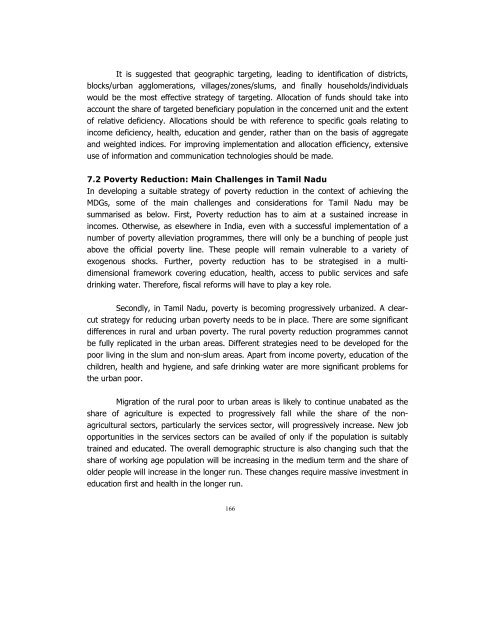POVERTY REDUCTION STRATEGY TN
You also want an ePaper? Increase the reach of your titles
YUMPU automatically turns print PDFs into web optimized ePapers that Google loves.
It is suggested that geographic targeting, leading to identification of districts,<br />
blocks/urban agglomerations, villages/zones/slums, and finally households/individuals<br />
would be the most effective strategy of targeting. Allocation of funds should take into<br />
account the share of targeted beneficiary population in the concerned unit and the extent<br />
of relative deficiency. Allocations should be with reference to specific goals relating to<br />
income deficiency, health, education and gender, rather than on the basis of aggregate<br />
and weighted indices. For improving implementation and allocation efficiency, extensive<br />
use of information and communication technologies should be made.<br />
7.2 Poverty Reduction: Main Challenges in Tamil Nadu<br />
In developing a suitable strategy of poverty reduction in the context of achieving the<br />
MDGs, some of the main challenges and considerations for Tamil Nadu may be<br />
summarised as below. First, Poverty reduction has to aim at a sustained increase in<br />
incomes. Otherwise, as elsewhere in India, even with a successful implementation of a<br />
number of poverty alleviation programmes, there will only be a bunching of people just<br />
above the official poverty line. These people will remain vulnerable to a variety of<br />
exogenous shocks. Further, poverty reduction has to be strategised in a multidimensional<br />
framework covering education, health, access to public services and safe<br />
drinking water. Therefore, fiscal reforms will have to play a key role.<br />
Secondly, in Tamil Nadu, poverty is becoming progressively urbanized. A clearcut<br />
strategy for reducing urban poverty needs to be in place. There are some significant<br />
differences in rural and urban poverty. The rural poverty reduction programmes cannot<br />
be fully replicated in the urban areas. Different strategies need to be developed for the<br />
poor living in the slum and non-slum areas. Apart from income poverty, education of the<br />
children, health and hygiene, and safe drinking water are more significant problems for<br />
the urban poor.<br />
Migration of the rural poor to urban areas is likely to continue unabated as the<br />
share of agriculture is expected to progressively fall while the share of the nonagricultural<br />
sectors, particularly the services sector, will progressively increase. New job<br />
opportunities in the services sectors can be availed of only if the population is suitably<br />
trained and educated. The overall demographic structure is also changing such that the<br />
share of working age population will be increasing in the medium term and the share of<br />
older people will increase in the longer run. These changes require massive investment in<br />
education first and health in the longer run.<br />
166

















